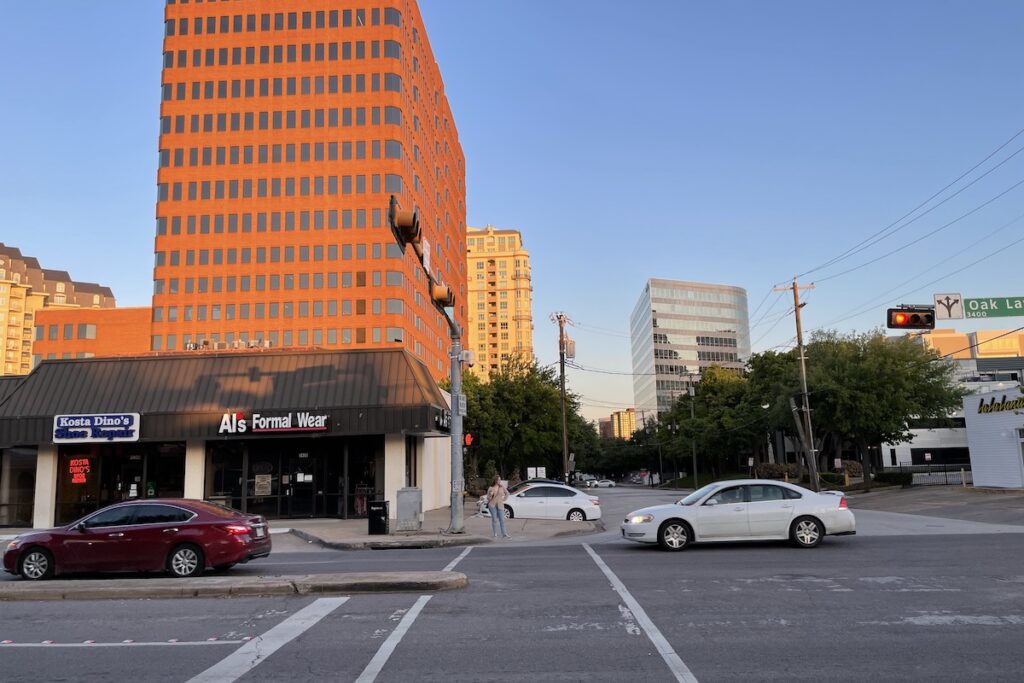Yesterday, the Dallas City Council’s Transportation and Infrastructure Committee questioned a proposed ordinance that seems tailored to target panhandling without explicitly saying as much. The proposed change would make it a Class C misdemeanor to stand on medians that are 6 feet wide or smaller.
The ordinance is written as a way to protect pedestrians. It cites “traffic studies” that find medians under 6 feet wide to not be a safe place for people to stand. It points to a “recommendation” from the Texas Department of Transportation that medians be at least 6 feet wide, echoed by the city’s own street design manual. During Monday’s meeting, Councilman Chad West requested those supporting documents; the city had not provided them, but an official said they would. The city’s transportation director summoned the goals of Vision Zero when answering questions from the council committee.
The change to the ordinance includes carve-outs for pedestrians who are “crossing a divided roadway in the most direct route possible.” You’re also safe if you’re a victim or rendering aid to someone, and if you have a permit to perform work, you’re exempt, too. So keep it moving.
The U.S. Supreme Court has ruled that panhandling—“charitable appeals for funds”—is constitutionally protected under the First Amendment. Which means cities can’t make panhandling itself illegal.
“The act of asking for money is protected activity, but municipalities can have different ordinances related to safety and public safety, pedestrians, those types of things,” said Ayeh Powers, an executive assistant city attorney. “So when you apply it to everybody, you should be OK.”
But who is really ever in the medians for any significant period of time?
“This ordinance would protect the pedestrians as they cross if they keep going and not be in that island,” said Ghassan Khankarli, the city’s director of transportation.
Khankarli had an anecdote: he received a report shortly before yesterday’s meeting that a car had run up on a median. (There were no pedestrians present.) Of course, cars drive up on sidewalks sometimes, too.
“So this is a safety ordinance and has nothing to do with what activity one might be doing on that median but has more to do with—the only activity that is prohibited is standing there,” Councilman Omar Narvaez said during his questioning.
“Is the intent on this about panhandling?” asked Councilwoman Cara Mendelsohn.
“It’s really pedestrian safety,” said Casey Burgess, another executive assistant city attorney.
At least one other city has run afoul of the courts with a similar move. In 2015, the Oklahoma City Council approved an ordinance that prohibited “most activities” in city medians within 200 feet of an intersection. The police chief showed images and accident reports. Council members declared it was a “safety issue.”
“The city argued medians were dangerous, casting the ordinance as a public safety necessity,” the Oklahoman reported at the time.
The American Civil Liberties Union of Oklahoma filed a lawsuit on behalf of a newspaper vendor, two joggers, a journalist, and an activist who protested in the medians. A judge in 2021 ruled in their favor, voiding the ordinance and ordering Oklahoma City to pay over $1 million in legal fees.
As Narvaez noted, Dallas’ ordinance wouldn’t outlaw specific activities beyond being stationary in a median or designated zones where cars or trucks face difficulty stopping. Which means it outlaws everything except crossing the street. Mendelsohn had more context. This matter originated in a meeting of the Government Performance and Financial Management Committee in October of last year. That body was discussing panhandling.
Despite the ordinance redefining standing in the median as a Class C misdemeanor—a speeding ticket, basically, punishable by a fine of up to $500—it was not intended to be “punitive.” Mendelsohn characterized the discussion last October as finding another tool to steer folks who are panhandling to city services.
“Just reading it, it doesn’t say the fullness of what I think the discussion has been,” Mendelsohn said.
Councilmembers questioned whether other activities would be allowed, like “fill the boot” firefighter donations and protests. Anyone wanting to do anything in the median would need permission from the city.
West wanted to know whether pedestrians could stand in bike lanes and curb bump-outs. (Those are common in cities such as Seattle and Chicago, where the city extends the curb into a lane so that pedestrians can have more space from vehicle traffic. West has been pushing for them in Dallas.) Staff didn’t have a good answer.
Narvaez said he didn’t think the language in the ordinance was ready just yet and asked staff to take another whack at it. The City Council could vote on it later this month.
Get the D Brief Newsletter
Author





